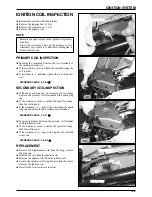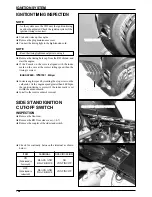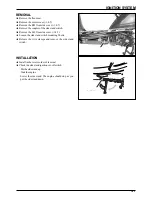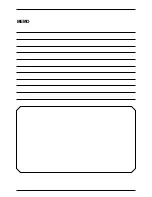
15-1
15. BATTERY/CHARGING SYSTEM
SERVICE INFORMATION
WARNING
·
Do not place flammable materials near battery when charging. This can be a fire hazard as hydrogen gas is created
during charging battery.
·
Do not allow battery acid to come into contact with clothes, skin or eyes. Battery acid contact can cause burns or loss of
eye sight. If contact occurs, thoroughly clean with water, and if acid enters eyes, flush with water and see a doctor.
·
If battery acid gets on clothing, as it can seep through or make a hole through the clothing and make its way to the skin,
make sure to change clothing that has come into contact with battery acid and wash the battery acid from the clothes.
CAUTION
·
This vehicle has a maintenance-free(MF) battery. Because MF batteries use different charging equipment, take special
care when performing maintenance and especially when replacing parts. Not all regular battery equipment is
compatible with MF batteries.
·
When charging the battery, remove the battery from the frame and do not open stopper.
·
There is the possibility of damaging the regulator/rectifier, etc. if the terminal or coupler is separated/connected when
electricity is over flowing through the electrical devices. Make sure to turn the main switch OFF when performing
maintenance to the charging equipment.
●
If the battery is allowed to repeatedly lose all its charge, is repeatedly over-charged, or if it is left in an un-charged state,
the battery can be damaged, its life can be reduced, or it can lose some of its strength. It is important to note here that the
battery will naturally last 2-3 years of normal use, and although it will re-charge, its load is reduced, leading to a loss in
battery strength.
●
It is possible for the battery to become overcharged from battery body load. If a battery cell becomes short-circuited and
if a state develops where voltage is not created between the terminals, the regulator will not operate and excessive
voltage will develops where voltage is not created between the terminals, the regulator will not operate and excessive
voltage will develop in the battery and normal cell electrolytes will decrease.
●
If the vehicle is not used for a long period, make sure to chage the battery every three months. If not so, the battery
ability to store electricity is reduced.
●
For information on generator disassembly, refer to section 8.
15
SERVICE INFORMATION
·
··
··
··
··
·
15-1
CHARGING DEVICES LOCATION
·
·
15-2
TROUBLESHOOTING
·
··
··
··
··
··
·
15-3
BATTERY
·
··
··
··
··
··
··
··
··
··
··
·
15-4
CHARGING SYSTEM INSPECTION
·
·
15-4
ITEM
STANDARD VALUES
SPECIFICATIONS
BATTERY
A.C.GENERATOR
REGULATOR /
RECTIFIER
Capacity
Terminal-to-terminal voltage (When fully charged)
Charging current
Leakage current
Charging coil resistance value ( 20
°
C )
rpm at charging start
Type
Regulator voltage
12V - 8AH (MF)
13.0 - 13.2V
0.8A
Not to exceed 1mA
0.1 - 1.0
Ω
( 20
°
C )
1,800rpm (night load)
Thyristor system
14.5
±
0.5V / 5,000rpm
TOOLS
DIGITAL TESTER, PVA MULTI-TESTER, RPM TESTER, BATTERY TESTER
HEADLIGHT VOLTAGE INSPECTION
·
·
15-6
REGULATOR/RECTIFIER INSPECTION
·
·
15-6
A.C. GENERAR CHARGING COIL
INSPECTION
·
··
··
··
··
··
··
··
·
15-7
Summary of Contents for HISTORY 125 - SERVICE
Page 1: ......
Page 28: ...MEMO...
Page 51: ...MEMO...
Page 52: ...FUEL SYSTEM 5 0 FUEL TANK FUEL STRAINER FUEL PUMP CARBURETOR...
Page 66: ...7 0 LH CRANKCASECOVER KICKSTARTER CONTINUOUSLYVARIABLE TRANSMISSION LH CRANKCASE COVER...
Page 83: ...MEMO...
Page 84: ...8 0 FLYWHEEL STATOR COMP RH SHROUD COOLING FAN A C GENERATOR STARTER CLUTCH...
Page 93: ...MEMO...
Page 110: ...10 0 CYLINDER PISTON CYLINDER CYLINDER GASKET PISTON TOP RING SECOND RING OIL RING...
Page 117: ...MEMO...
Page 118: ...11 0 TRANSMISSION CRANKSHAFT CRANK CASE RH CRANKCASE LH CRANKCASE CRANKSHAFT...
Page 129: ...MEMO...
Page 157: ...MEMO...
Page 158: ...BRAKE SYSTEM 14 0...
Page 170: ...MEMO...
Page 178: ...MEMO...
Page 186: ...MEMO...
Page 207: ...SERVICEMANUAL 2001 11 PRINTED 2001 11 PUBLICATION NO COPY...
















































